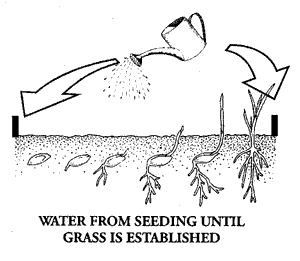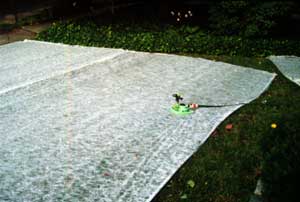Water, Water, Water
It is impossible to over-emphasize how important faithful watering is to grass seed germination. Immediately after overseeding the lawn, begin watering. A thorough gentle watering is essential to get things off to a good start. Then move into a watering routine as best you can. Try for twice daily watering, minimum, if there is no rain. You do not have to water for hours and hours. The idea is to keep just that top ¼ inch of soil moist so the seed stays moist. Be sure to cover the entire overseeded area each time.
 |
If you are home to water the new grass seed twice a day, use an automatic timer to do the job. Set the mechanical or computerized timer to turn on your watering device for just a short period in the morning and then again for another light watering in the afternoon. Some timers can be set for up to 7 days. If new grass sprouts appear in four or five days don't suspend the watering routine. Keep watering. Most quality grass mixtures include a "nurse" grass such as perennial rye that pops up quickly. It is there to protect the other seed--the tall fescue and/or Kentucky bluegrass types--which take from 10 to 20 interminable days to germinate. This early nurse grass also helps the morale of the yardener who is invariably encouraged to see results so soon. Keep watering. See Lawn Watering Devices in the Tool Shed.
Use a Mulch (Optional)
A mulch over your newly overseeded lawn is helpful but definitely optional. The most important benefit of a mulch is to reduce water evaporation and therefore reduce the chances of the grass seed drying out and reducing seed germination rates. The existing turf stubble serves as something of a mulch, and so does a topdressing if you choose to spread one.
However, for an extra measure of protection, spread a mulch as the last step in overseeding.
 |
Although hay or straw is commonly used for this purpose, white, polyspun garden fleece, also called floating row cover, is excellent for protecting seed and new grass seedlings. Available in garden centers and hardware stores for a variety of landscape and garden uses, it allows air, light and water through, so water right over it. Remove it when it is time to mow the existing lawn.
Garden fleece:
Helps prevent the seed from drying out. D
iscourages birds from eating the new seed. Raises the temperature over the seedbed to speed germination. Assures more complete germination is reusable.
Mowing New Grass
Take special care when mowing a newly overseeded lawn. Normally, two inches or more is the recommended mowing height, but this is an exception. When the older, established grass recovers from its close cut and grows to about 1 or 1½ inches, mow the lawn, new grass and all. For the next six weeks, as it gets cooler, keep the grass at 1 or 1½ inches.
This is one of the rare times when it is a good idea to collect grass clippings when you mow. Mowing more closely and collecting the clippings, helps the new grass seedlings get more light to encourage good strong growth.
Followup Fertilizing (Optional)
If you use a slow-acting granular fertilizer in the overseeding process, a followup fertilizer snack is helpful, but not essential. A month to six weeks after the new grass appears, spray it with a liquid lawn fertilizer. Use any of the liquid lawn fertilizers for use with a hose end sprayer, but take care that the product does not include any pesticide. This snack gives the new grass an extra boost to get it well on its way.

